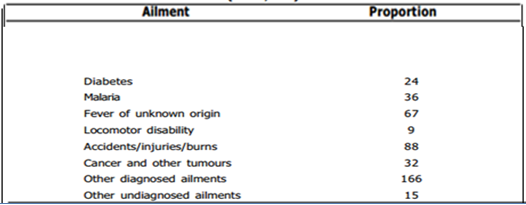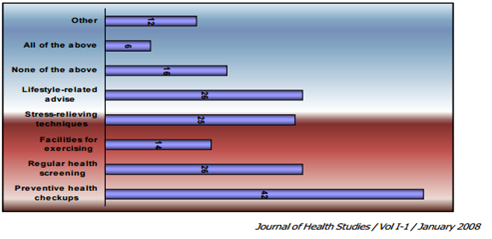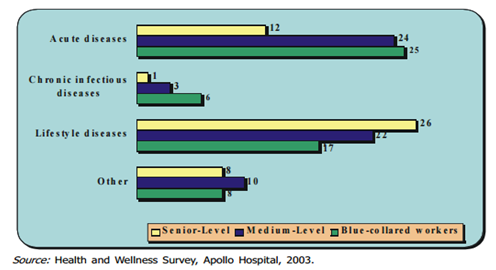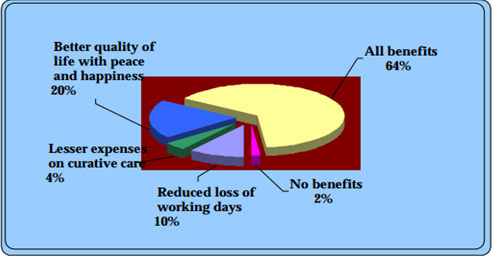Some studies have tried to quantify the stress levels among young people, while others have given a mean stress score (influenced by methods of measuring stress). Sahoo et al using Depression Anxiety Stress Scale (DASS) observed that 20 per cent young adults experienced stress. Dabut et al using life stress scale found that among adolescent girls studying in 12th standard, 47.5 and 72.5 per cent, were in the moderate category of family stress; financial stress was reported by 60 and 50 per cent and, 90 and 85 per cent had moderate level of social stress, respectively. Sharma & Sidhu in a study, among adolescents aged 16-19 yr using self-made questionnaire based on Bisht Battery of Stress found that 90.6 per cent adolescents had academic stress.
Health & Behavioral Risk and soft skills among Young & working People in India
Population aged 10-24 years accounts for 373 million (30.9%) of the 1,210 million of India's population with every third person belonging to this age group. Among them, 110 and 273 million live in urban and rural India, respectively. Males account for 195 million and females 178 million, respectively6. As per the National Sample Survey (NSS), (2007-08) 32.8 per cent of this group attend educational institutions and 46 per cent (2004-05) are employed7.
Young people's health is vital and crucial
Most young people are presumed to be healthy but, as per WHO, an estimated 2.6 million young people aged 10 to 24 yr die each year and a much greater number of young people suffer from illnesses ‘behaviors’ which hinder their ability to grow and develop to their full potential.
Nearly two-thirds of premature deaths and one-third of the total disease burden in adults are associated with conditions or behaviors initiated in their youth (e.g. tobacco use, physical inactivity, high risk sexual behaviors, injury and violence and others).
The behavioral patterns established during this developmental phase determine their current health status and the risk for developing some chronic diseases in later years.
It is crucial to understand health problems of this population, processes and mechanisms that affect their health identify interventions and strategic approaches that protect their health and develop.
Health problems of young & working people
Although adolescence and young adulthood are generally considered healthy times of life, several important public health and social behaviors and problems either start or peak during these years. Most of these problems are linked with social determinants and lifestyles operating and interacting in complex environments that precipitate or trigger these conditions or behaviors.
Developmental transition of young people makes them vulnerable particularly to environmental, contextual or surrounding influences. Environmental factors, including family, peer group, school, neighborhood, policies, and societal cues, can both support or challenge young people's health and well-being.
Available evidence indicates that young people are prone to a number of health impacting conditions due to personal choices, environmental influences and lifestyle changes including both communicable and non-communicable disorders and injuries. Others include substance use disorders (tobacco, alcohol and others), road traffic injuries (RTIs), suicides (completed and attempted), sexually transmitted infections (STI) including human immunodeficiency virus (HIV) infection, teen and unplanned pregnancies, homelessness, violence and several others.
Conversely, overweight and obesity - another form of malnutrition with serious health consequences is increasing among other young people in India. A meta-analysis of nine studies in 2012 showed 12.6 per cent of children to be overweight and 3.3 per cent to be obese indicating the seriousness of the situation.
A review of a few select studies, during 2001 to 2012 showed a prevalence of overweight among children aged 10-19 yr to be 9.9 to 19.9 per cent; high in both boys (3 to 15.1%) and girls (5.3 to 13.3%) indicating early onset of obesity affecting more of urban school adolescents (3.4 to 6.5%) as compared to 0.6 per cent among the rural adolescents15 with significant gender variations.
Studies from Karnataka have shown a higher prevalence of obesity as compared to studies from northern India.
There is also a challenge of nutritional transition as Indians are moving away from traditional diets high in cereal and fiber to more western pattern diets high in sugars, fat, and animal-source food (fast food culture) that are closely associated with different non communicable diseases (NCDs) seen in later years.
At least 20 per cent of young people are likely to experience some form of mental illness - such as depression, mood disturbances, substance abuse, suicidal behaviors, eating disorders and others.
A meta-analysis of five psychiatric epidemiological studies yielded an estimated prevalence of mental morbidity including 16 mental and behavioral disorders (classified into eight groups of organic psychosis, schizophrenia, manic affective psychosis, manic depression, endogenous depression, mental retardation, epilepsy, phobia, generalized anxiety, neurotic depression, obsession and compulsion, hysteria, alcohol/drug addiction, somatisation, personality disorders and behavioral/emotional disorders) of 22.2 per 1000 population among 15 to 24 years.
Stress
Suicide
According to the World Health Organization (WHO) estimates about one million people commit suicide each year. In India, nearly 1, 36,000 persons voluntarily ended their lives in a suicidal act as per official reports in 201163. The official report indicates that age specific suicide rate among 15-29 yr is on the rise increasing from 3.73 to 3.96 per 1,00,000 population per year from 2002 to 2011. About 40 per cent of suicides in India are committed by persons below the age of 30 yr.
Study from Bangalore showed that of the 5115 attempted suicide covering all age groups, 2.1, 8.4 and 28.6 per cent individuals were in the age group 10-15, 16-20 and 21-25 yr, respectively; and among 912 completed suicides, 2.2, 16.2 and 21.6 per cent were in the age group 10-15, 16-20 and 21-25 years, respectively.
NCDs include a number of conditions that are behavior linked and lifestyle related in nature. Indian population, especially young people, is passing through a nutritional transition and is expected to witness higher prevalence of adult non-communicable diseases such as hypertension, diabetes and chronic lung diseases in the coming years.
Multiple health behaviors and co-morbid conditions
It is important to highlight that some behaviors and conditions listed above and several others not covered here do not occur in isolation but are often seen as coexisting behaviors and as co-morbid conditions.
Depression and obesity are closely linked to a number of NCDs and depression in particular with suicides. The Health Behavior Study in Bangalore covering nearly 10,000 individuals aged 18 to 45 yr from urban, rural, slum and transitional areas reported that 30 per cent had more than five behaviors/conditions existing in the same individual. Evidence from National Household Survey showed that over 26 per cent adult men found to be alcohol users also had higher prevalence of STIs. Thus, it becomes apparent that while addressing one problem becomes critical, addressing multiple issues in an integrated manner.
The importance of investing in youth has been recognized in India's Constitution. One of the Directive Principles of State Policy, states that “…it is imperative that children are given opportunities and facilities to develop in a healthy manner and in conditions of freedom and dignity and that childhood and youth are protected against exploitation and against moral and material abandonment”.
Soft Skills
A study attributed to Harvard University found that when a person gets a job or promotion, 85 % of the time it is because of the attitude (Social & Emotional Skill) and only 15 % of the time because of intelligence & Knowledge (IQ) of specific facts & figures.
Social and Emotional skills applies to every sphere of life, including one’s personal and professional life. Can a student be a good student without a good attitude? Can parents, teachers, sales persons, employers or employees be good in their roles without good attitude?
The foundation of success, regardless of the chosen field, is the social & emotional skills
The NASSCOM-McKinsey report ``Perspective 2020: Transform Business, Transform India`` (2009) said that only 26 percent of India's engineering graduates were employable. Narayana Murthy, Chairman Emeritus of Infosys, has questioned the quality of engineering graduates from Indian Institutes of Technology (IITs). An Associated Chambers of Commerce and Industry of India (ASSOCHAM) survey reported that only 10 percent of Master of Business Administration (MBA) graduates from Indian B-schools get a job right after completing their course (2012).
These reports and many others indicate that the employability or non-employability of Indian graduates is a rising concern. To understand how the gap between employers and potential employees can be bridged, India Education spoke with Himanshu Aggarwal, CEO of Aspiring Minds, one of India's employability measurement solutions providers. The company conducts the Aspiring Minds' Computer Adaptive Test (AMCAT).
Journal of Health Studies
Journal of Health Studies / Vol I-1 / January 2008:
The study tries to analyze the relationship between preventive healthcare and the productivity and profitability of Indian companies. An online survey of Indian companies and their employees was conducted to gauge their views on preventive healthcare by Alka Chadha, National University of Singapore Ali Mehdi, Indian Council for Research on International Economic Relations and Garima Malik Indian Council for Research on International Economic Relations published in Journal of Health Studies / Vol I-1 / January 2008
The results show that Indian companies are aware of the importance of preventive healthcare and most of them have some provision for regular health checkups. They are increasingly considering prevention as an investment for human capital to improve efficiency and creativity of the employees. While liberalization of the Indian economy has expanded opportunities for employment and additional incomes, it has also brought with it urbanization and changes in lifestyles. These changes have had a profound impact on the epidemiology of diseases and healthcare demands of the people. The rising demand for healthcare has brought into focus the inadequacies of the present healthcare system, public as well as private. With this background, our study tries to suggest certain initiatives that can be taken by the government, such as tax incentives for companies practicing preventing healthcare.
Among working adults in India
- Relationship between disease & economic growth
- Estimates of losses in National Income due to Chronic Diseases
- Distribution of people Hospitalizes by Ailment in Urban Areas 1 & 2
- Preventive Health care measures offered by companies
- Major Afflictions According to Management Grades
- Man Days lost owing to sickness
- Benefits from preventive health care companies in employees Survey
Relationship between disease & economic growth

Estimates of losses in National Income due to Chronic Diseases
(US $ Billion, 1998 prices)






